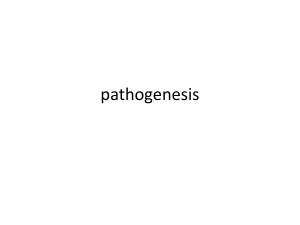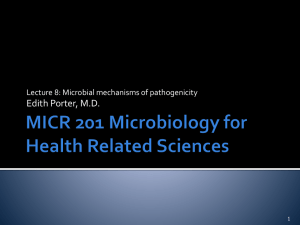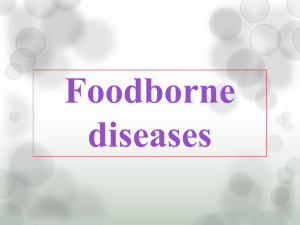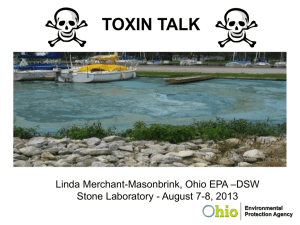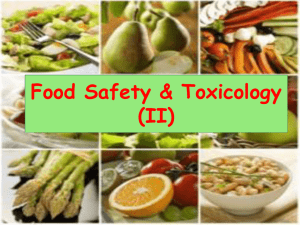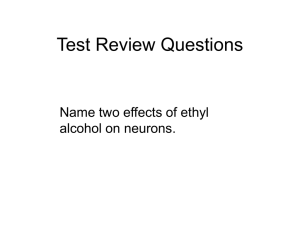evolution_of_bacterial_protein_toxins
advertisement
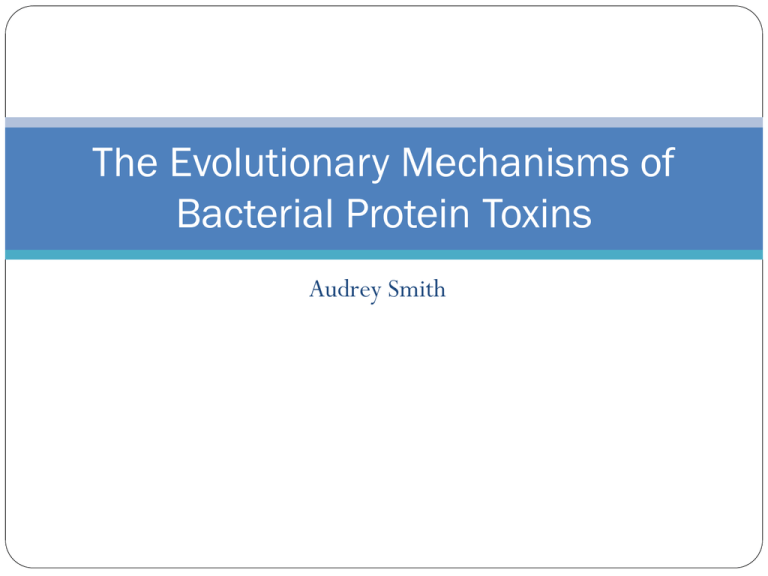
The Evolutionary Mechanisms of Bacterial Protein Toxins Audrey Smith Overview This presentation will: Introduce bacterial toxins Introduce the field of phylogenetics Introduce some basic concepts of bacterial genetics Describe how I constructed a phylogenetic tree to investigate the evolution of bacterial protein toxins Discuss the results of that phylogenetic tree What are bacterial toxins? Bacterial toxins are substances produced by bacteria that are capable of causing harm to a host. Many Gram-negative bacteria have lipopolysaccharide toxins associated with their cell walls. Bacterial protein toxins are usually secreted, and are produced by a wide variety of bacteria. Because they are proteins they are encoded by genes, and the DNA sequences can be analyzed. Why are they important? Bacterial protein toxins are responsible for, or complicate, many human diseases: Tetanus MRSA Pertussis Botulism Toxic Shock Syndrome Food Poisoning Scalded Skin Syndrome And many more; there are currently over 130 identified bacterial protein toxins Types of bacterial protein toxins They can be grouped according to their mechanism of action, or pathogenic strategy. Some examples of categories are: Pore-forming toxins Protease toxins Protein synthesis inhibiting toxins Second messenger activating toxins Superantigen toxins Pore forming toxins These proteins are capable of transforming from a water- soluble form to a membrane bound form. Some act as monomers, but most are homo-oligomers, with pentamers, hexamers, and heptamers being common arrangements. Larger arrangements also occur, especially in the cholesteroldependant cytolysin family, which may have 50 or more subunits per pore. A wide variety of microbes, including bacteria produce these toxins. Pore forming toxins These toxins insert into the membrane of cells and form non-regulated pores. This can allow ions, water, and small molecules to freely enter and exit, causing death of the cell To the right is an illustration of pneumolysin, a pore forming toxin produced by Streptococcus pneumoniae Protease Toxins This is a small category, consisting only of the clostridial neurotoxins tetanus toxin and botulinum toxin, but is interesting because of the diseases they cause: tetanus and botulism, respectively. Tetanus toxin cleaves synaptobrevin, which prevents the release of inhibitory signals of skeletal muscle contraction, resulting in rigid paralysis. Botulinum toxin cleaves SNAP-25, which prevents the release of stimulatory signals of skeletal muscle contraction, resulting in flaccid paralysis. Protease Toxins An illustration of a man suffering from the rigid paralysis of tetanus A duckling suffering from the flaccid paralysis of botulism Protein Synthesis Inhibiting Toxins Protein synthesis inhibiting toxins block elongation factors that are required to move RNA transcripts through ribosomes. When these factors are blocked, new proteins cannot be synthesized, which leads to cell death. Toxins in this group are responsible for diphtheria and bacilliary dysentery, and contribute to Pseudomonas aeruginosa infection. Second Messenger activating toxins These toxins modify cellular proteins involved in signaling pathways. The most common targets are G-proteins and rho. The modified proteins result in either up- or downregulation of the normal end product of the pathway, with clinical results varying widely depending on the targeted pathway. Cholera, Whooping Cough, and Diphtheria are all caused by toxins in this category. Superantigen toxins These toxins non-selectively activate host T-lymphocytes. This causes a massive over-reaction of the immune system, causing systemic inflammation and in severe cases, a dangerous drop in blood pressure. Most known superantigens are produced by bacteria in genus Staphlococcus. The toxins can cause toxic shock syndrome, rheumatic fever, and food poisoning. What is phylogenetics? Phylogenetics is the study of evolutionary relationships between organisms. Sequenced genes are compared to determine how similar they are. Conserved genes that are found in all of the organisms to be compared are used. For wide-range studies genes for 16S rRNA or cytochrome C are often used because they are found in all organisms. The comparison data is used to construct a graphic representation called a phylogram, or phylogenetic tree. 16S rRNA Phylogram Bacterial Genetics Bacteria can pass on their genetic material in two important ways: Vertical gene transfer This is passing of genetic material from parent cell to daughter cells through simple mitosis. Both daughter cells produced in mitosis are identical clones of the parent cell. Horizontal gene transfer This is passing of genetic material from one cell to another unrelated one. Sometimes the cells involved are not the same species. Horizontal gene transfer is sometimes referred to as sexual reproduction in bacteria. Horizontal Gene Transfer (HGT) There are three primary mechanisms by which HGT can occur: Transformation Where genes are transferred as small circular pieces of DNA called plasmids Transduction Where genes are transferred by viral bacteriophages Conjugation Where genes are transferred via physical contact of the two cells. Usually the cells are joined by a pilus. Mobile genetic elements When looking for genes that are likely to be transferred between bacteria, one should look for genes encoded on plasmids and in bacteriophages, since they are mobile genetic elements that facilitate HGT. It is known that antibiotic resistance is transferred by HGT, and that genes for some toxins are also transferred this way. HGT and phylogenetic studies When the objective of a phylogram is to illustrate the relationship of whole organisms, highly conserved genes are compared. If less conserved genes were used, the resulting phylogram would show organisms that have undergone HGT as being more related than they really are. By analyzing such a phylogram for these discrepancies, it is possible to see where HGT has occurred. Finding out which toxins are undergoing HGT Bacterial toxins are a serious public health concern. It would be advantageous to know if, and which, bacterial toxin genes pass between bacterial populations. A phylogram to identify points of HGT can be constructed with a multiple sequence alignment tool. For this project I used the ClustalW2 program from the European Bioinformatics Institute to analyze toxin gene sequences that I obtained from the National Center for Biotechnology Information Gene database. Choosing the toxins to compare Phylogenetic analysis works better when the genes being compared are somewhat similar. Also, HGT is more likely to occur in genes located on plasmids and bacteriophages. With this in mind I chose several toxin genes from each functional toxin group already discussed here, and particularly looked for any encoded on plasmids or bacteriophages. I made phylogenetic trees for each toxin group, then one comparing all of the toxins together. The results Interpreting the phylogenetic tree Each ‘branch’ of the tree represents the evolutionary distance between the toxins it connects. Therefore, the toxins connected by shorter branches are more related to each other. It is expected that these toxins would be from the same bacteria, or closely related ones. If they are from very different bacteria, HGT has likely occurred. In the tree, we see a group of toxins connected by short branches, all of which are protein synthesis inhibitor toxins Closely Related Groups The protein synthesis inhibitor toxins This tree shows the protein synthesis inhibitor group. The group highlighted in red are all Shiga toxin 1, isolated from S. dysenteriae, two strains of E. coli and a bacteriophage. The group in blue are all Shiga toxin 2, isolated from three strains of E. coli and a bacteriophage. Diphtheria Toxin and Exotoxin 1 are also shown, but do not appear to be particularly related to either Shiga toxin group. Shiga toxins Shiga toxin 1 and Shiga toxin 2 are two different proteins that perform the same pathogenic action through the same receptor. They have one A subunit that stops protein synthesis inside cells, and 5 identical B subunits that help get the A subunit into the cell. These toxins are similar in structure and function to the plant toxin ricin. These toxins cause bacilliary dysentery; some cases also develop Hemolytic Uremic Syndrome, which can be fatal. I used the gene for the B subunit for these comparisons because there were more sequenced isolates available than of the A subunit. Shiga toxin 1 The gene for this toxin is found in Shigella dysenteriae, some strains of Escherichia coli (called Shiga Toxin-producing Escherichia coli or STEC), and in at least one known bacteriophage. Because nearly identical genes for this toxin are found in unrelated bacteria and in a bacteriophage, it can be concluded that Shiga toxin 1 undergoes HGT at least between S. dysenteriae and E. coli. Shiga toxin 2 The gene for this toxin is not present in S. dysenteriae. It only appears in strains of STEC, and in at least one bacteriophage. With just this evidence, it cannot be determined if Shiga toxin 2 undergoes HGT or not. A closer look at toxin genes from STEC strains may reveal if HGT occurs within E. coli. Conclusions By phylogenetic analysis it has been confirmed that HGT occurs with Shiga toxin 1 between at least two distinct bacterial species. HGT may occur with Shiga toxin 2 between different strains of E. coli. Where to go from here Because of the scope of this project, the number of toxins studied was limited. Repeating the experiment with more toxin genes may reveal incidents of HGT missed here. The Shiga toxins should be studied in greater detail to determine if there are any other organisms capable of receiving these genes. Since the plant toxin ricin is very similar in structure and function to the Shiga toxins, it would be of interest to determine the relationship between them, and if some form of genetic transfer occurred in the evolution of either toxin. Sources Alouf, Joseph E, and Michel R Popoff. The Comprehensive Sourcebook of Bacterial Protein Toxins. 3rd. Burlington: Academic Press, 2006. Print. CDC, Escherichia coli o157:h7 and other Shiga toxin-producing Escherichia coli (stec). N.p., 2011. Web. 25 Apr 2012. <http://www.cdc.gov/nczved/divisions/dfbmd/diseases/ecoli_o157h7/ . "ClustalW2 - Multiple Sequence Alignment." EMBL-MBI. EMBL-MBI, 2012. Web. 25 Apr 2012. <http://www.ebi.ac.uk/Tools/msa/clustalw2/>. . Gene. N.p., n.d. Web. 25 Apr 2012. <http://www.ncbi.nlm.nih.gov/gene/>. Hartl, Daniel L, and Elizabeth W Jones. Genetics: Analysis of Genes and Genomes. 6th. Sudbury: Jones and Bartlett, 2005. Print. Madigan, Michael T., Thomas D. Brock, et al. Brock Biology Of Microorganisms. 12. San Francisco: BenjaminCummings Pub Co, 2009. Proft, Thomas. Microbial Toxins: Molecular and Cellular Biology. Norfolk: Horizon Bioscience, 2005. Print. Photos: AFIP. Duck. Flaccid paralysis characteristic of botulism. N.d. Photograph. Center for Safety and Public HealthWeb. 25 Apr 2012. <http://www.cfsph.iastate.edu/DiseaseInfo/clinical-signs-photos.php?name=botulism>. LAGUNA DESIGN/SCIENCE PHOTO LIBRARY. Pore forming bacterial toxin. N.d. Graphic. Science Photo LibraryWeb. 25 Apr 2012. NYPL/SCIENCE SOURCE/SCIENCE PHOTO LIBRARY. Opisthotonos. N.d. Painting. Science Photo LibraryWeb. 25 Apr 2012.

